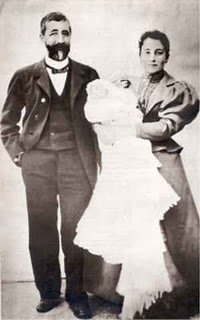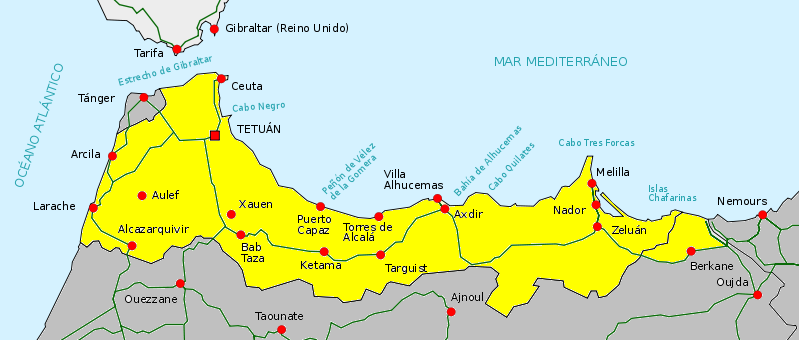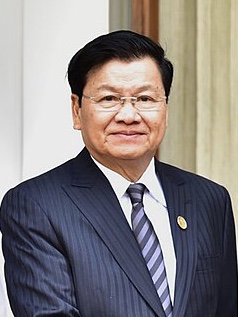|
Francoist
Francoist Spain (), also known as the Francoist dictatorship (), or Nationalist Spain () was the period of Spanish history between 1936 and 1975, when Francisco Franco ruled Spain after the Spanish Civil War with the title . After his death in 1975, Spain transitioned into a democracy. During Franco's rule, Spain was officially known as the Spanish State (). The informal term "Fascist Spain" is also used, especially before and during World War II. During its existence, the nature of the regime evolved and changed. Months after the start of the Civil War in July 1936, Franco emerged as the dominant rebel military leader and he was proclaimed head of state on 1 October 1936, ruling a dictatorship over the territory which was controlled by the Nationalist faction. The 1937 Unification Decree, which merged all of the parties which supported the rebel side, led to Nationalist Spain becoming a single-party regime under the FET y de las JONS. The end of the Civil War in 1939 brou ... [...More Info...] [...Related Items...] OR: [Wikipedia] [Google] [Baidu] |
Francisco Franco
Francisco Franco Bahamonde (born Francisco Paulino Hermenegildo Teódulo Franco Bahamonde; 4 December 1892 – 20 November 1975) was a Spanish general and dictator who led the Nationalist faction (Spanish Civil War), Nationalist forces in overthrowing the Second Spanish Republic during the Spanish Civil War and thereafter ruled over Spain from 1939 to 1975, assuming the title ''Caudillo''. This period in Spanish history, from the Nationalist victory to Franco's death, is commonly known as Francoist Spain or as the Francoist dictatorship. Born in Ferrol, Spain, Ferrol, Galicia, into an upper-class military family, Franco served in the Spanish Army as a cadet in the Toledo Infantry Academy from 1907 to 1910. While serving in Spanish protectorate in Morocco, Morocco, he rose through the ranks to become a brigadier general in 1926 at age 33. Two years later, Franco became the director of the General Military Academy in Zaragoza. As a Conservatism, conservative and Monarchism, ... [...More Info...] [...Related Items...] OR: [Wikipedia] [Google] [Baidu] |
Una, Grande Y Libre
The mottos of Francoism are mottos which encapsulate the ideals of the Francoist dictatorship. Although the regime had many ideological influences (Traditionalism, National Catholicism, Militarism and National syndicalism), it employed Falangism in its popular movements. Falangist ideology was easily incorporated in the creation of mottos as it is believed to demonstrate a certain reluctance towards political agendas, and to favour empiricism, taking action, and the simplification of ideas. Although these mottos originated from the activity of different right-wing intellectuals and nationalist political parties during the Second Spanish Republic, their use became widespread and proved to be an effective propaganda tool used by the Nationalist faction during the Spanish Civil War (1936–1939) in mobilising public opinion and persuading the population to conform to nationalist ideas. Mottos were also often used as political chants during Franco's dictatorship (1939–1975). As ... [...More Info...] [...Related Items...] OR: [Wikipedia] [Google] [Baidu] |
Totalitarianism
Totalitarianism is a political system and a form of government that prohibits opposition from political parties, disregards and outlaws the political claims of individual and group opposition to the state, and completely controls the public sphere and the private sphere of society. In the field of political science, totalitarianism is the extreme form of authoritarianism, wherein all socio-political power is held by a dictator. This figure controls the national politics and peoples of the nation with continual propaganda campaigns that are broadcast by state-controlled and state-aligned private mass communications media. The totalitarian government uses ideology to control most aspects of human life, such as the political economy of the country, the system of education, the arts, sciences, and private morality of its citizens. In the exercise of socio-political power, the difference between a totalitarian regime of government and an authoritarian regime of government is ... [...More Info...] [...Related Items...] OR: [Wikipedia] [Google] [Baidu] |
National Catholicism
National Catholicism ( Spanish: ''nacionalcatolicismo'') was part of the ideological identity of Francoism, the political system through which the Spanish dictator Francisco Franco governed the Spanish State between 1939 and 1975. Its most visible manifestation was the hegemony that the Catholic Church had in all aspects of public and private life. As a symbol of the ideological divisions within Francoism, it can be contrasted to national syndicalism (Spanish: ''nacionalsindicalismo''), an essential component of the ideology and political practice of the Falangists. History The invention of the term is attributed to the Jesuit and historian Alfonso Álvarez Bolado, who gave the term a scientific nuance and whose articles were compiled by the publishing house Cuadernos para el Diálogo in 1976, before, the term was used more informally. In France, a similar model of National Catholicism was advanced by the Fédération Nationale Catholique formed by General Édouard Caste ... [...More Info...] [...Related Items...] OR: [Wikipedia] [Google] [Baidu] |
Alejandro Rodríguez De Valcárcel
Alejandro Rodríguez de Valcárcel y Nebreda (25 December 1917 – 22 October 1976) was a Spanish falangist politician and State lawyer, who served in important positions during the dictatorship of Francisco Franco. Biography Born in December 1917 in Burgos to a bourgeois family, he joined the Sindicato Español Universitario (SEU) in 1934. A ''camisa vieja'' Falangist, he entered the Civil War as volunteer in a ''Bandera'' of Falange. From 27 November 1969 to 5 December 1975 he served as the President of the Francoist Cortes. He was a chief endorser of the (ANEPA). In the capacity of President of the Council of Regency, he briefly served as acting Head of State, from Franco's death on 20 November to 22 November 1975, when then Prince Juan Carlos took an oath and was proclaimed King of Spain The monarchy of Spain or Spanish monarchy () is the constitutional form of government of Spain. It consists of a Hereditary monarchy, hereditary monarch who reigns as the ... [...More Info...] [...Related Items...] OR: [Wikipedia] [Google] [Baidu] |
Madrid
Madrid ( ; ) is the capital and List of largest cities in Spain, most populous municipality of Spain. It has almost 3.5 million inhabitants and a Madrid metropolitan area, metropolitan area population of approximately 7 million. It is the Largest cities of the European Union by population within city limits, second-largest city in the European Union (EU), and its wikt:monocentric, monocentric Madrid metropolitan area, metropolitan area is the List of metropolitan areas in Europe by population, second-largest in the EU.United Nations Department of Economic and Social AffairWorld Urbanization Prospects (2007 revision), (United Nations, 2008), Table A.12. Data for 2007. The municipality covers geographical area. Madrid lies on the Manzanares (river), River Manzanares in the central part of the Iberian Peninsula at about above mean sea level. The capital city of both Spain and the surrounding Community of Madrid, autonomous community of Madrid (since 1983), it is also th ... [...More Info...] [...Related Items...] OR: [Wikipedia] [Google] [Baidu] |
Marcha Real
The (; ) is the national anthem of Spain. It is one of only four national anthems in the world – along with those of National Anthem of Bosnia and Herzegovina, Bosnia and Herzegovina, Inno Nazionale della Repubblica, San Marino and Anthem of the Republic of Kosovo, Kosovo – that have no official lyrics. Although many different lyrics have been made for it in the past, it has never had official lyrics as a national anthem. History One of the oldest in the world, the Spanish national anthem was first printed in a document dated 1761 and entitled (''Book of the Ordinance of Newly Played Military Fife (musical instrument), Fife and Drum Calls by The Spanish Infantry''), by Manuel de Espinosa. There, it is entitled (). According to the document, Manuel de Espinosa de los Monteros is the composer. There is a misconception that its author was Frederick II of Prussia, a great lover of music. That mistaken belief arose in 1861 when it was published as fact in the periodic ... [...More Info...] [...Related Items...] OR: [Wikipedia] [Google] [Baidu] |
Flag Of Spain
The flag of Spain (), as it is defined in the Spanish Constitution of 1978, Constitution of 1978, consists of three horizontal stripes: red, yellow and red, the yellow stripe being twice the height of each red stripe. Traditionally, the middle colour was called by the archaic term (Reseda luteola, weld, a natural dye); hence the flag's nickname (the red–weld). The middle stripe often bears the coat of arms of Spain. The origin of the current flag of Spain is the naval ensign of 1785, , by Decrée of Charles III of Spain, where it is also referred as ''national flag''. It was chosen by Charles III himself from 12 different flags designed by Antonio Valdés y Bazán. All proposed flags were presented in a drawing, which is in the Naval Museum of Madrid. The flag remained marine-focused for most of the next 50 years and flew over coastal fortresses, marine barracks and other naval property. During the Peninsular War, the flag could also be found on marine regiments fighting ... [...More Info...] [...Related Items...] OR: [Wikipedia] [Google] [Baidu] |
Tangier International Zone
The Tangier International Zone (; ; ) was a international zone centered on the city of Tangier, Morocco, which existed from 1925 until its reintegration into independent Morocco in 1956, with interruption during the Spanish occupation of Tangier (1940–1945), and special economic status extended until early 1960. Surrounded on the land side by the Spanish protectorate in Morocco, it was governed under a unique and complex system that involved several European nations, the United States (mainly after 1945), and the Sultan of Morocco, himself under a French protectorate in Morocco, French protectorate. Due to its status as an international zone, Tangier played a crucial role for Moroccan nationalists, who wanted independence, to establish international contacts and recruit allies as well as organising gatherings and events. Background: early international governance in Tangier For nearly a century after the end of English Tangier, English rule in 1684, Tangier was primarily ... [...More Info...] [...Related Items...] OR: [Wikipedia] [Google] [Baidu] |
One-party
A one-party state, single-party state, one-party system or single-party system is a governance structure in which only a single political party controls the ruling system. In a one-party state, all opposition parties are either outlawed or enjoy limited and controlled participation in elections. The term "''de facto'' one-party state" is sometimes used to describe a dominant-party system that, unlike a one-party state, allows (at least nominally) multiparty elections, but the existing practices or balance of political power effectively prevent the opposition from winning power. Membership in the ruling party tends to be relatively small compared to the population. Rather, they give out private goods to fellow elites to ensure continued support. One-party, compared to dominant-party dictatorships, structure themselves unlike democracies. They also turn into multi-party democracies at a lower rate than dominant-party dictatorships. While one-party states prohibit opposition p ... [...More Info...] [...Related Items...] OR: [Wikipedia] [Google] [Baidu] |
Spanish Sahara
Spanish Sahara (; ), officially the Spanish Possessions in the Sahara from 1884 to 1958, then Province of the Sahara between 1958 and 1976, was the name used for the modern territory of Western Sahara when it was occupied and ruled by Spain between 1884 and 1976. It had been one of the most recent acquisitions as well as one of the last remaining holdings of the Spanish Empire, which had once extended from the Americas to the Spanish East Indies. Between 1946 and 1958, the Spanish Sahara was amalgamated with the nearby Spanish-protected Cape Juby and Spanish Ifni to form a new colony, Spanish West Africa. This was reversed during the Ifni War when Ifni and the Sahara became provinces of Spain separately, two days apart, while Cape Juby was ceded to Morocco in the peace deal. Spain gave up its Saharan possession following Moroccan demands and international pressure, mainly from United Nations resolutions regarding decolonisation. There was internal pressure from the native ... [...More Info...] [...Related Items...] OR: [Wikipedia] [Google] [Baidu] |





